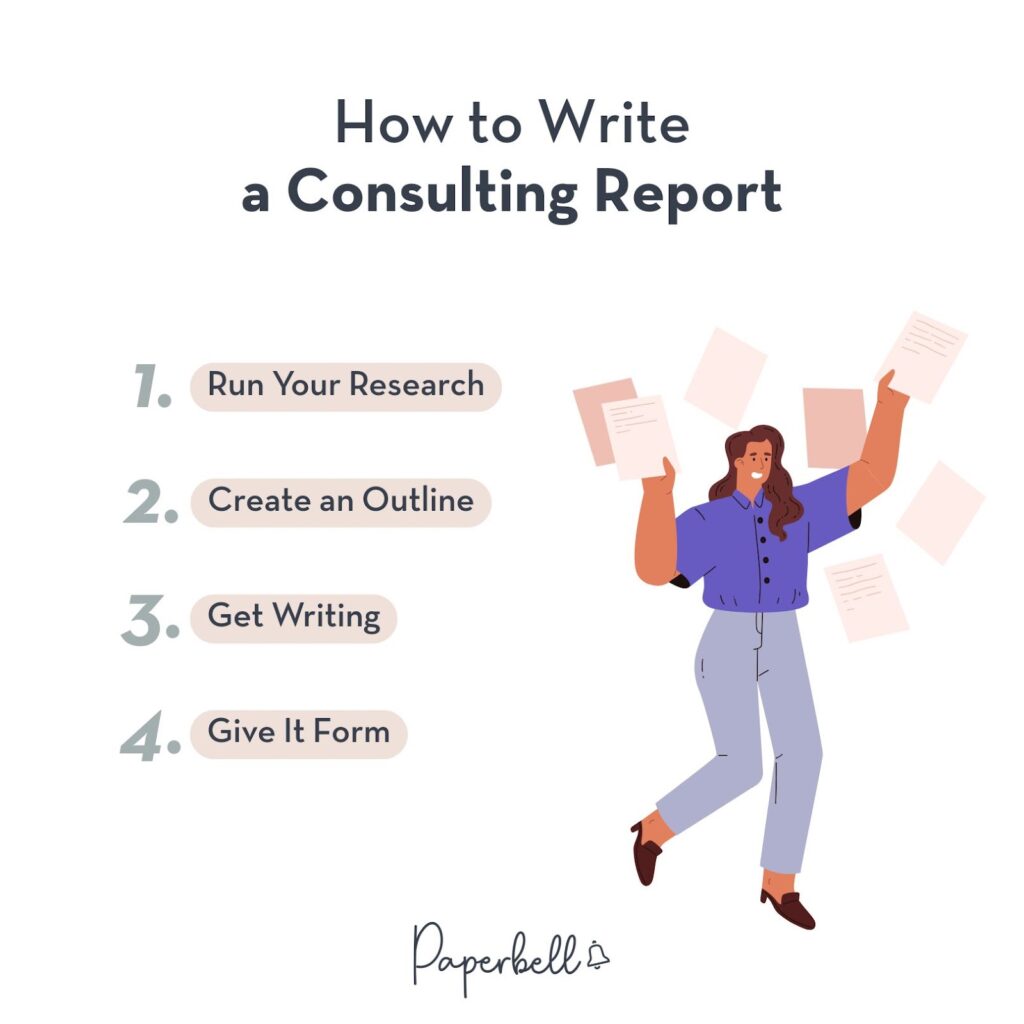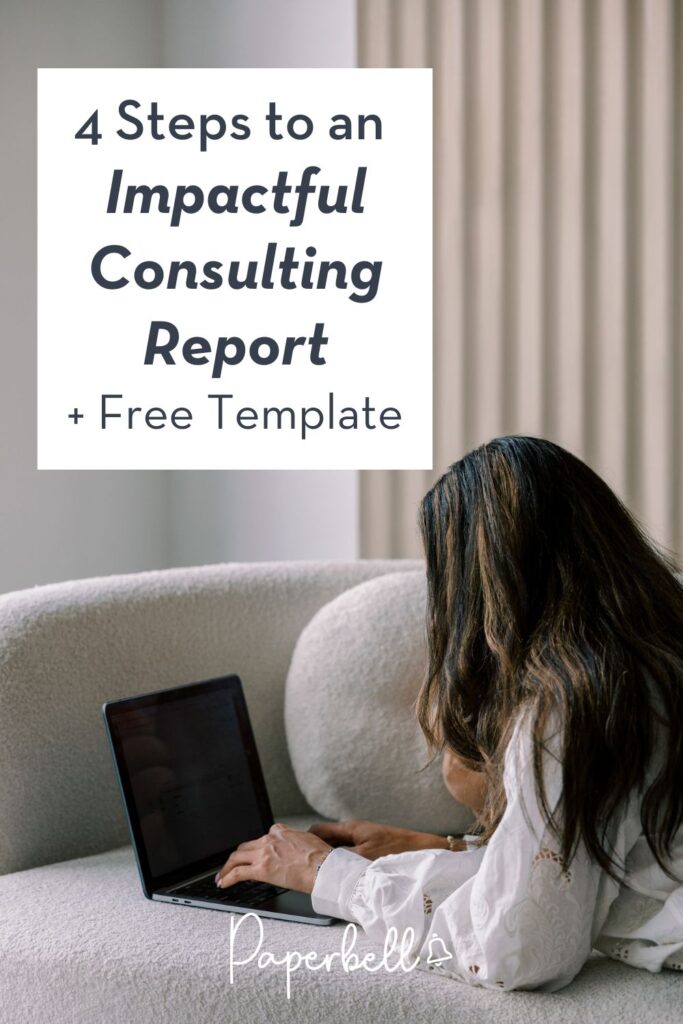Research and data are the backbone of helping clients make informed decisions and grow their business. However, in a consulting session, there’s only so much depth you can cover. So where do you showcase your expertise and highlight your findings?
In your consulting reports.
Company leaders depend on critical insights but rarely have time to run the analysis themselves. That’s where you come in. Conducting industry research and breaking down what worked and what didn’t, not only adds value to your current contract but also sharpens your expertise as a consultant.
Research alone isn’t enough, though. To position yourself as an expert, you need to present findings in a way that’s thorough yet easy to digest.
In this article, we’ll cover everything a strong consulting report should include and how to present it effectively.
What Is a Consulting Report?
A consulting report can take many different forms, but at its core, it is a written piece of in-depth research prepared by an expert (that’s you!). It guides the reader through the most relevant data points on a given subject and explains what those numbers mean in practice.
Consulting reports are usually focused on a specific problem or challenge an organization is facing, presenting solutions that have been examined from several angles. Everything that is too detailed to cover in a client meeting or presentation belongs in your consultant report.
When done well, a report becomes an asset your clients can return to and use as a foundation for major decisions, sometimes years after it was created. It also gives you a chance to demonstrate strategic thinking.
[ Read: What Does a Consultant Do? (And Why It’s Your New Favorite Career) ]
A strong consulting report is well structured and easy to follow. It covers all aspects of the issue, offers fresh insights that clients would not easily find on their own, and turns complex data into clear, actionable findings. This makes it a reliable tool for high-stakes decision-making.
Pro tip: Keep all your consulting reports, notes, and client materials in one place with Paperbell, so you never lose track of insights between sessions.
5 Consulting Report Examples
1. Project Summary
The final steps in any project are to:
- Analyze the results
- Summarize the lessons learned
- Evaluate the decisions that were made
This stage is crucial, yet it is often overlooked by project leads.
Whether it is a project you managed directly or one you advised on, a project summary is an effective way to present actionable insights to your client. With these takeaways, they can:
- Adjust internal processes
- Increase cost savings
- Improve future outcomes
If you have an ongoing engagement with a client, you may also be asked to analyze several projects within a year and prepare an annual business summary. This type of consultant report often becomes the foundation for setting new company objectives and metrics, ensuring that last year’s insights directly shape next year’s strategy.
2. Industry Reports
Consulting firms often issue industry reports to give companies a broader view of:
- What competitors are doing
- How they can position themselves more effectively in the market
A competitor analysis highlights the value other businesses deliver to customers while revealing gaps and opportunities that remain untapped.
These reports can also spotlight new products, services, or even potential entrants who could disrupt the market. With this knowledge, business leaders can make smarter product decisions and recruit talent aligned with emerging trends.
Industry reports can also strengthen your position in your niche as a consultant. By specializing in a particular market, you build credibility and become the go-to expert for businesses in that space.
[ Read: How to Put Together A Consulting Agreement + Free PDF Template ]
3. Business Case Study
Business case studies are a powerful way to present proven solutions that have delivered results. A well-crafted case study can save your client significant time and resources by offering a tested path instead of relying on trial and error.
Case studies typically:
- Outline the core challenge a company faced and the broader client context.
- Walk through the reasoning behind potential solutions, explain why one was chosen, and show how it was implemented.
- Highlight some measurable outcomes achieved and the key lessons that can be applied going forward.
Using your own case studies also gives you a chance to flex with client success you’ve created in the past.
4. Business Model Comparison
Choosing a business model is a long-term decision that must stand the test of time. It should always be grounded in solid data and research. As a consultant, you can guide clients by analyzing the models their competitors use or by helping them design a new approach that maximizes profit margins.
A report comparing business models or business plans usually examines factors such as:
- Customer segments: niche markets versus mass markets
- Customer relationships: the type of engagement and support clients will expect
- Distribution channels and partnerships: opportunities for reaching customers and collaborating with strategic partners.
- Cost structure and revenue streams: how the model will impact expenses and profitability
By breaking down these elements, you help clients evaluate which model aligns best with their goals and resources.
5. Social Media Reports
This type of business consulting report is most common in businesses where social media plays a central role in marketing and branding. These reports act as:
- Progress check-ins
- Reviewing strategic goals for each channel
- Tracking performance over a set time period
They showcase the top-performing content and campaigns while providing feedback on what resonated with followers.
When preparing a social media report, focus on the metrics that truly reflect business progress. Avoid vanity numbers that may look impressive but say little about whether the company is moving closer to its objectives.
How to Write a Consulting Report
A consulting report only creates strategic value if the findings can be put into practice within your client’s business. In many cases, the majority of your work will be spent with research (rather than writing itself) to make sure your recommendations are accurate, relevant, and actionable.
The silver lining is that writing business consulting reports will get easier once you roll out a few. Here are the key steps to follow when writing one:

1. Run Your Research
You don’t want to start writing until you’ve gathered, reviewed, and organized all relevant information. Request access to company documentation if needed, check marketing and sales analytics, interview key stakeholders, and pull data from reliable industry sources.
2. Create an Outline
Give your report a structure that fits the type of project you’re working on. A clear outline not only keeps your writing organized but also helps you estimate how much time each section will take. A general structure might look like this:
- Cover page: Title of the report, publication date, your name, and the client’s name.
- Table of contents: Chapters and page numbers for easy navigation.
- Executive summary: A short overview of your main findings and recommendations, aka the TL;DR of the business world for busy executives.
- Introduction: Sum up the project scope, why its central issue matters, plus any background information that may affect how key observations in your report are understood.
- Analysis: Each option or objective examined, supported by data and research.
- Key findings: Results of your analysis, along with potential solutions.
- Conclusion: A recap of your research and the most promising solution(s).
- Appendix (optional): References and additional resources that support your work.
3. Get Writing
Once your research and outline are solid, the writing itself should flow more easily. Start drafting, then revise through one or two rounds of edits. Always proofread carefully, or better yet, have someone else give it a fresh read.
4. Give It Form
After the content is finalized, format and design your report so it looks professional. You don’t need expensive design software; tools like Canva or Visme can create polished layouts quickly. You can also use our free template below to give your research a professional finish.
[ Read: 23 Free Life Coaching Resources to Get Your Little Paws on Right Now ]
How to Write an Executive Summary for a Consulting Report
Although the executive summary appears at the beginning of your business consulting report, it should be written last, after the rest of your research is complete. Because it is a condensed version of the full report, it needs to briefly cover the issue under review, your findings, and the most important facts or figures that support them.
For a standard report just a few pages long, the executive summary should be no more than a single paragraph. If the report is more extensive (closer to an ebook in length), it can stretch to one or two pages. This allows space for more visuals, such as graphs or charts, to convey data better and keep the client engaged.
How to Create a Consulting Report Cover Page
The cover page of your business consulting report should display these key elements:
- The report title
- Any subtitle
- Your name as the author
- The client’s name
This shows the report was created specifically for them, not pulled from a generic template.
Your cover page creates the first impression of your work. Treat it with the same care as the rest of the report by using thoughtful colors, fonts, and design elements that reflect your brand.
If you are an independent consultant without set brand guidelines, you can use a professional template to give your report a polished look. At minimum, choose highly readable fonts and leave plenty of white space so the design feels clean rather than crowded.
Use Our Free Consulting Report Template
To get you started, here’s our recommendation report template you can use to make sure your research will be well-received.
Mid-Quarter Consulting Report [Q4]
Manhattan Division Project
Prepared By: Eve Smith, Marketing Consultant
Prepared For: Dream & Co. Ltd.
01.02.2026
Table of Contents
Executive Summary
Introduction
Insight #1
Insight #2
Insight #3
Key Finding #1
Key Finding #2
Key Finding #3
Conclusion
Appendix
Page X of the consultant report
Page Y of the consultant report
Page Z of the consultant report
Executive Summary
This is where you would sum up the key insights of your report.
Make sure you write this section of your report last, after your entire analysis is done. Explain the main challenge or hypothesis that was the reason for writing this report in a sentence or two.
Then move on to the most important insights of your analysis, sort of what you would highlight with a marker while studying a paper.
You can also include the most significant supporting data or statistics backing up your proposed business impact without going into too much detail. Keep it short, informative, and convincing.
Introduction
Your introduction should describe the central issue your consultant report is about.
For a project summary or a periodical report, you may list the initiatives that you and your client focused on.
For this report, the key elements may be industry trends or players you’ll examine in your analysis, and the reason for choosing them.
You can also explain why certain metrics were analyzed in your research and not others.
All in all, this is where you provide context for your readers about your core subject, explain the “why” behind it, and provide an angle through which they can understand your analysis better.
Insight #1
Now is the time to get down to the details and explain the key points of your core subject. Consulting frameworks or a simple SWOT analysis could come in handy here.
SWOT Analysis
| Strengths | Weaknesses |
| Better profit marginsImproved customer experience | High production costsHigh competition |
| Opportunities | Threats |
| New emerging marketsNew outsourcing model | Mismatch with current business modelUnclear projection on turnover |
Insight #2
Drop in your best statistics and graphs here that support your statements.
Metrics & Analytics
| KPI | Target | Result |
| Engagement | 2.6% | 2.3% |
| Reach | 5.4 million | 5.7 million |
| Comments | 500 | 625 |
| Influencer Mentions | 10 | 12 |
Insight #3
Provide information about your key metrics, competitors, or business models here for your client to consider.
Key Findings #1
Now that you’ve explained everything the client needs to know about the subject, you can propose some solutions for the central issue.
Key Findings #2
Be specific about why you think this could work for your client and how it would look in practice.
Key Findings #3
Of course, don’t forget to explore the potential risks of each solution as well, in a few key points. Examine them from multiple angles.
Conclusion
Sum up your consulting report and give suggestions on the steps ahead.
Highlight the solution once again that you think would best benefit your client, and set clear expectations on what it would entail to implement it.
Appendix
1 John Biel, The History Of Social Media, New York Times, 2021
2 Carrie Smith, Is Freemium Really The Future?, Penguin Books, 2018
Google Docs Consulting Report Template
Use this Google Doc consulting report template to impress your clients. Simply go to File > Make a copy to save and start editing.

Editor’s Note: This post was originally published in May 2022 and has since been updated for accuracy.









